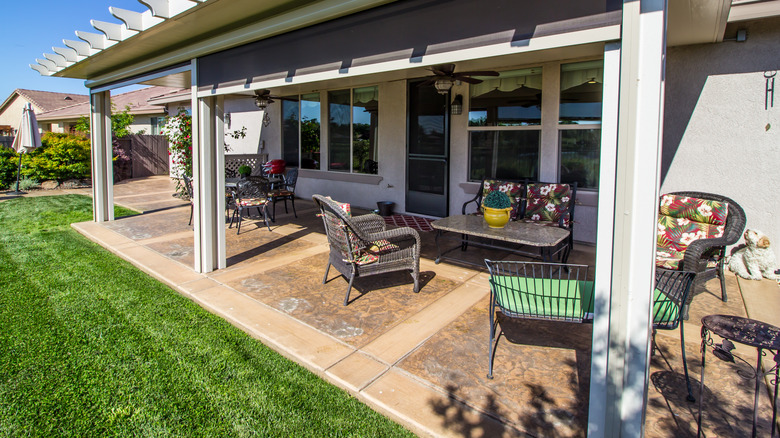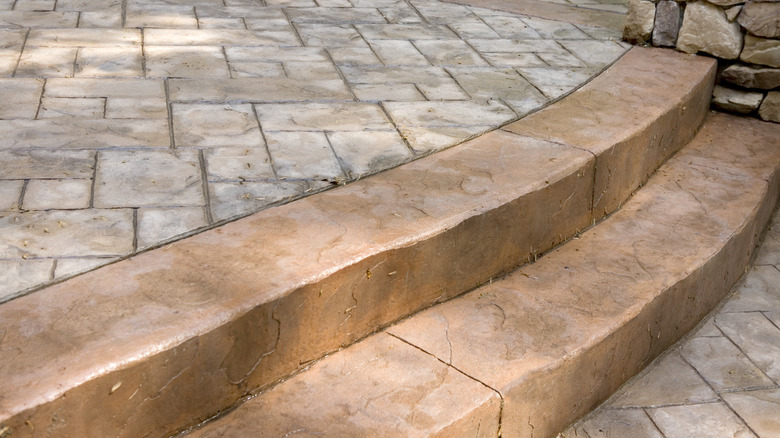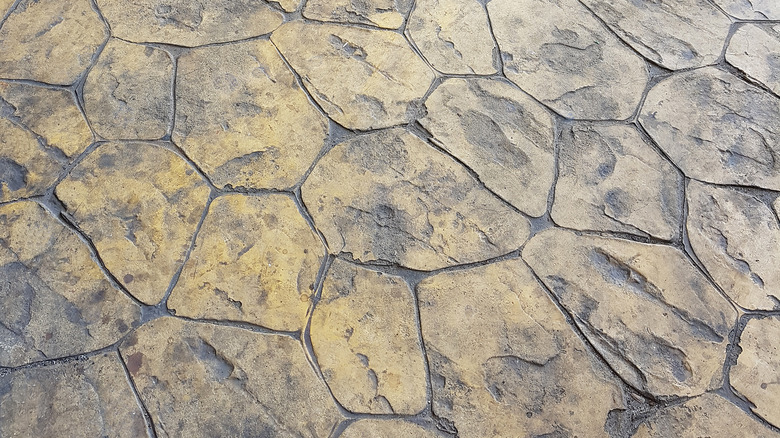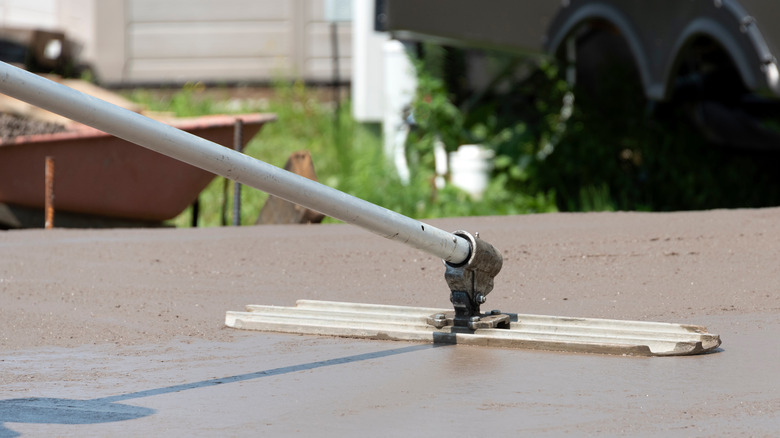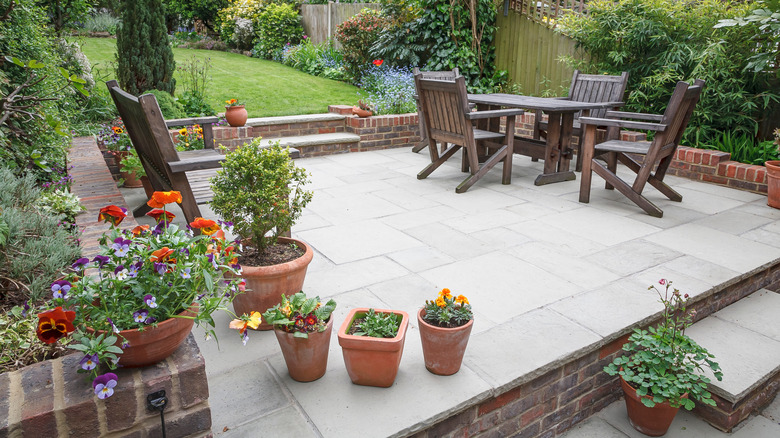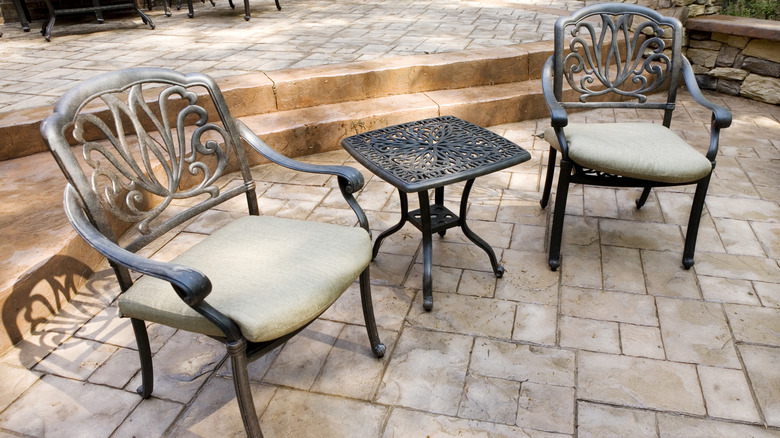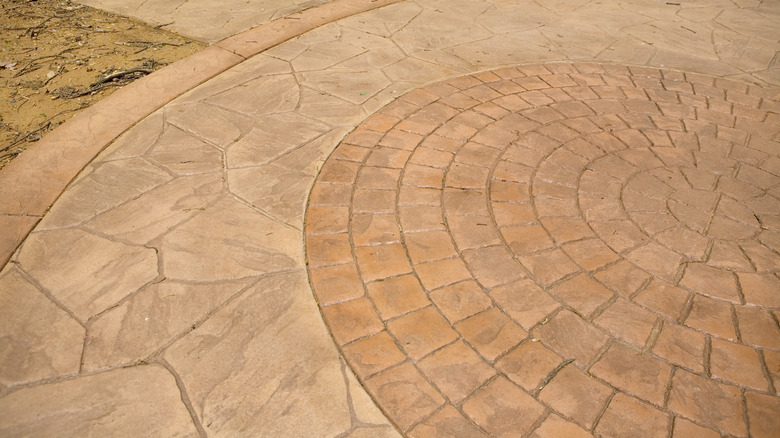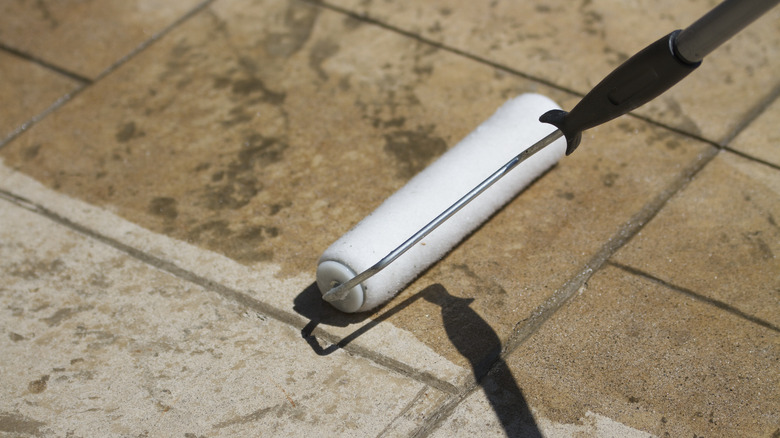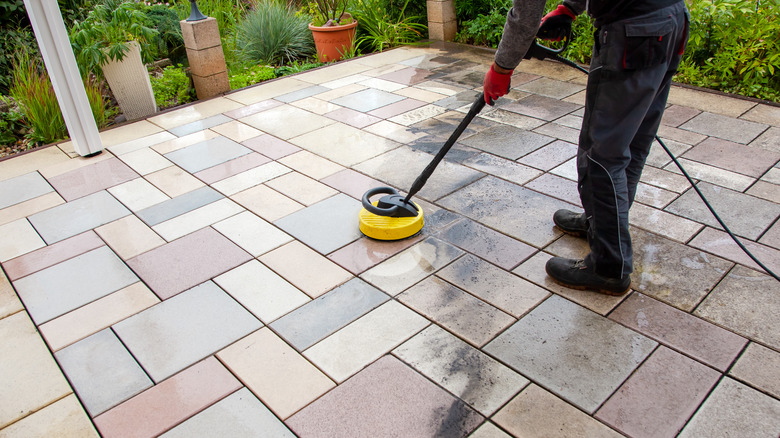Everything You Need To Know Before Acid Staining A Concrete Patio
A dull slab of gray concrete may look great for a very particular decorating style, but for many of us, the patio should be as lovely as the home and garden around it. You can leave the dull patio behind in several ways that don't include throwing in the towel and replacing it. Acid staining your concrete patio can take a couple of hours to a couple of days, but in the end, your patio will be as unique as the rest of your home.
Acid staining is a permanent process that involves a chemical reaction within the pores of the concrete. You can buy acid stain by the gallon at your local hardware store, so it is completely possible to DIY it on a weekend. However, there are some important points that you should know before you pull the trigger. Here is everything you need to consider before gathering your supplies and getting started.
Results will vary
Concrete is a mix of water, cement, and other materials like sand and gravel. Every mix has a different ratio of ingredients, and as the concrete is mixed, the sand and gravel are spread around at random. This means that one corner of your concrete patio is not exactly the same as another corner, even if they look identical on the surface.
It is important to understand the diverse nature of concrete on an atomic level because the chemical reaction of the staining process is between the acid and these randomly dispersed minerals. No two patios will be the same even when using the same acid stain and technique. Even if the product you buy claims to produce burnt orange results, that may not be the color you end up with after you follow all of the steps.
You also will not know the results until all of the steps are completed. You must neutralize the acid, wash off all residue, and allow it to dry completely. Then, the true color will be revealed.
Acid staining is permanent
As the name implies, acid staining is very permanent. It's tempting to believe that everything can be undone when a mistake is made, but in this case, there's no going back. Because it is a chemical reaction within the concrete, it cannot be reversed or scraped off. If you truly hate the color or pattern you end up with, the only way to fix it is to embark on a rigorous refinishing process or pour a brand-new surface.
That isn't the ideal scenario though, so there are some tips to help prevent such a negative outcome. First, whenever possible you should test the product on a small, hidden part of your patio. Think of it like dabbing a new lotion on the back of your hand to see if you have a reaction before you smear it all over your face. Second, if you start with a diluted stain, you can always apply more coats to make the color darker. This is a great way to gain more control over the result if you have the patience to follow through.
Gather supplies before you begin
Gathering everything you need before you begin a project seems like a no-brainer, but it is worth hammering home for this project. It may be tempting to go to The Home Depot, buy a gallon of acid stain, and pour it on your patio. However, you'll likely end up with an unsightly mess, some ruined siding, and possibly a few acid burns.
The first supplies you should make sure you have before you begin are cleaning supplies and personal protective equipment. You can use a push broom, hose, and a power washer to clean your concrete from interfering debris. These can also help you spread the stain and wash off the residue at the end. You will also want to protect the siding of your home with paper or plastic if it is in the splash zone. For your protection, you will want some gloves and safety glasses while handling the acid.
Then you will need the actual staining supplies as well. Along with the acid stain, you will need a neutralizer. The acid doesn't stop reacting until there is nothing left to react with or until it is neutralized by another material. To neutralize an acid you apply a base. One easy-to-acquire, weak base is ammonia, or you can mix baking soda with water.
Consider factors that will impact the finished look
One thing to keep in mind if you're installing the concrete is that the acid stain will chemically react with the concrete. So, it needs to be able to soak into the surface. There are small air pockets in concrete, called pores, that the stain needs to seep into to create a deep color. While troweling the surface as smooth as glass seems ideal aesthetically, it closes access to these pores. The stain will pool on the surface, just to be washed off hours later. Plus, a tightly troweled concrete surface can be slippery in general.
For already finished concrete, you should take stock of your surface finish before acid staining. Pour a little water on the patio and see how long it takes to soak in. This will give you an indication of how well the stain will soak in as well. If the water pools on the surface, then your finish may be too tight. In that case, some light sanding or buffing can be done to break through.
However, tight troweling isn't the only possible culprit for poor stain absorption. Cleaning the surface thoroughly is very important to ensure open pores. Grease, oil, glue, and anything else that may block liquid must be scraped or scrubbed off before you start. You can also a power washer or a mixture of water and trisodium phosphate (TSP) to deeply clean the patio.
The age of the concrete matters
While older concrete may have some trouble accepting the acid stain, there isn't an age limit. You may have more problem spots to be sanded or re-touched, but it's unlikely that your surface is too old. However, concrete can be too new to acid stain. If you have a freshly poured patio, there are two metrics it should meet first. It needs to be at least 28 days old and completely one, consistent color. Once it's completely cured, you can proceed.
The good news is that by starting with a new patio, you can set yourself up for success. You can choose to broom the finish for example. You can also set up a little experiment to help you visualize your stain. Since you're pouring a batch of concrete anyway, put aside several small squares of it for color testing. Now you can see how your concrete will react to a specific stain without risking the whole patio.
Consider factors that impact the finished look
Acid stains are sold by color, but your choices are limited. Unlike paint, acid stains mostly come in shades of brown. Because you can achieve colors ranging from a gentle tan to a rich burnt orange, it's still a great way to bring warmth to your patio.
However, dry stain and wet stain do look distinctly different from each other. Once completely dry, the colors look lighter and more matte than when they're wet. To get more of a permanent wet look, you can add a semigloss water-based sealer after the patio is neutralized and dried. Think of this sealer as an invisible shield. Not only will it look good, but it will also help protect the longevity of your concrete patio.
To set yourself up for success, there are a couple of important things to remember early on. First, avoid using a curing agent on new concrete. It will block the stain from soaking into the pores like a sealer would. Second, strangely enough, the red chalk that many contractors use will also seep into the pores and stain! To avoid a permanent chalk line, make sure any markings are done in blue chalk instead.
Get creative with your color and texture
While acid staining creates unique designs, there are small details that you can control that will affect how smooth the color and texture will be. For example, a textured finish will accept color differently. A broom finish won't have that interesting marbled look that is common for concrete acid staining projects. The rock-salt finish has pockmarks instead of groves, so it can look more marbled.
When applying the stain, you can spray it on, brush it on, or do a combination of the two. To spray it on, buy a plastic pump sprayer like this one from Lowes. By spraying, you aren't likely to have application lines left over, but it may also be less uniform. Brushing the acid stain involves moving it around the surface in deliberate circular motions to create a more consistent stain. Be very careful though because brushing puts you much closer to the acid that can burn your skin.
You may also consider a combination of the two techniques. If you have a more complicated design, you can brush the detailed pieces and spray the broader areas. Or you may want to spray on the stain, and then use a brush over the whole floor. Either way, the goal is to avoid leaving any puddles of stain.
Be mindful of maintenance requirements
With so many constrictions around acid-staining concrete, it's easy to consider painting instead. However the biggest positive is how permanent and low maintenance it is if done correctly. Paint will fade and chip, but acid stain will not. It has chemically reacted with the top layers of the concrete itself, so it isn't going to wear off or change much over time. The only exception is with blue and green hues of stain. While beautiful indoors, these stains will eventually turn black when used outdoors.
After many years, a patio that has high foot traffic or exposure to harsh weather may need to be repaired. To prolong the already long life of your concrete, you can seal it. Otherwise, simply sweeping away debris or spraying it with a hose should be enough to keep it clean. There is no need to do anything drastic with steaming or applying more acid for regular maintenance.
Cost depends on the project size and complexity
There are some general cost factors to consider when taking on a project like this. At the most basic, consider whether you want to hire a professional or do it yourself. Understanding the scope of acid staining your concrete patio to help with that decision. Do you have a lot of the equipment to prepare and apply the stain already? If you're a DIY veteran, then you may take the chance to avoid labor costs by doing it yourself. However, if you have never done a project like this, you run the risk of messing up, spending the money to fix it, and perhaps not even getting what you want in the end. In that case, labor costs might be more worth it for you.
The size of the patio and how complex the staining pattern will influence the cost. Also, the number of coats you apply as well as the number of stain colors you choose can push the total up a little higher. But if you keep it simple, it's a cost-effective way to bring some warmth and personality to a concrete patio.
